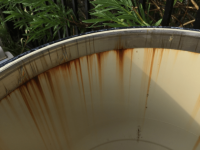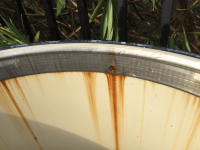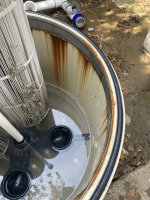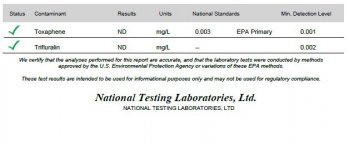- Jul 4, 2020
- 501
- Pool Size
- 20000
- Surface
- Vinyl
- Chlorine
- Salt Water Generator
- SWG Type
- Pentair Intellichlor IC-40



I'll bet you're exactly right. We have an ozonation/filtration system to bloom and remove it in the house, and I'm wondering if I should reroute the plumbing for the fill line so that it delivers treated water rather than directly from the well as it is now.Looks like colonizing iron bacteria, and same thing we treat in water wells. Chlorine purges generally prevent and clear it, but left long enough it will build up, harden in layers, and chlorine has a hard time removing it. See it all over pumps and plumbing when removed from well, but would not have expected to see it in a chlorine environment.
i have to say, that looks disgusting. ugh.Looks like colonizing iron bacteria, and same thing we treat in water wells. Chlorine purges generally prevent and clear it, but left long enough it will build up, harden in layers, and chlorine has a hard time removing it. See it all over pumps and plumbing when removed from well, but would not have expected to see it in a chlorine environment.
It lives in the soil of iron rich environments. A well can get contaminated with the bacteria if the envelope is broken for repairs, or, even during the dig when they lay drill stem on the ground or site to site drilling. It just happens more oft than not. The standard protocol regardless is to annually pour bleach down the well and in tank, about 1/2 gallon each spot, let it run a bit, sit a bit, then open all faucets in house and purge the bleach. If you ever let it cake up and harden, you will never completely rid it, as bleach cannot penetrate well enough. It's harmless, but sure can foul up stuff if allowed to get as bad as that pic.i have to say, that looks disgusting. ugh.
Could help, but kinda wondering how it grew and accumulated there. Just seems well chlorinated pool water would not have allowed it to take up home. Assume you keep your FC/CYA at a decent level?I'll bet you're exactly right. We have an ozonation/filtration system to bloom and remove it in the house, and I'm wondering if I should reroute the plumbing for the fill line so that it delivers treated water rather than directly from the well as it is now.
I've been pretty careful about levels, yes. I did get lax a few times this summer which resulted in overshooting FC once, but nothing over SLAM. I've also had some black goo in the skimmers at the water line and a SLAM earlier seemed to resolve that. I'll maybe see what happens next year and go from there.Could help, but kinda wondering how it grew and accumulated there. Just seems well chlorinated pool water would not have allowed it to take up home. Assume you keep your FC/CYA at a decent level?
We bought the house out of bankruptcy, and it for sure had been neglected. It was only8 years old, so it wasn't too bad, but the water system hadn't been maintained in some time.It lives in the soil of iron rich environments. A well can get contaminated with the bacteria if the envelope is broken for repairs, or, even during the dig when they lay drill stem on the ground or site to site drilling. It just happens more oft than not. The standard protocol regardless is to annually pour bleach down the well and in tank, about 1/2 gallon each spot, let it run a bit, sit a bit, then open all faucets in house and purge the bleach. If you ever let it cake up and harden, you will never completely rid it, as bleach cannot penetrate well enough. It's harmless, but sure can foul up stuff if allowed to get as bad as that pic.
That's usually body oils, suntan lotion and other personal care products that are introduced by people.I've also had some black goo in the skimmers at the water line and a SLAM earlier seemed to resolve that.
Here a well test is required before closing, mainly looking for harmful bacteria levels. I would still read up on treatment methods, it's easy to do, along with annual testing of the water, and adopt yourself a plan to keep it up for peace of mind. There's so much dead matter and live matter involved, the sludge might just accumulate there due to filter circulation, much like it will do in your toilet tank, but, would indicate it's growing somewhere.We bought the house out of bankruptcy, and it for sure had been neglected. It was only8 years old, so it wasn't too bad, but the water system hadn't been maintained in some time.
Rust is hard and crusty. The slimy sludge is kinda a giveaway that it's the bacteria matter, and the bacteria will be found on iron sources as energy/food source.In my opinion, it's just rust from defects in the stainless steel.
Bacteria is not going to live in chlorinated water.
It's happening under water, so it can be like a sludge.Rust is hard and crusty. The slimy sludge is kinda a giveaway that it's the bacteria matter, and the bacteria will be found on iron sources as energy/food source.
The 2 do go hand in hand, found together. You pull out a pipe and it's all rust corroded and slimy, so kinda treated synonymous. Oxidizing metal rusts, and, iron bacteria oxidizes metal to feed. Water filters can really tell you a lot about actual source, as the orange slime will cover them as it's filtered from source feeding below it.It's happening under water, so it can be like a sludge.
In any case, maybe you are correct, but I think that it is probably just rust.
It wasn't a requirement here, but I had one done when I put in the new water treatment system anyway just so I knew what I was dealing with. The water itself looks pretty good.Here a well test is required before closing, mainly looking for harmful bacteria levels. I would still read up on treatment methods, it's easy to do, along with annual testing of the water, and adopt yourself a plan to keep it up for peace of mind. There's so much dead matter and live matter involved, the sludge might just accumulate there due to filter circulation, much like it will do in your toilet tank, but, would indicate it's growing somewhere.







